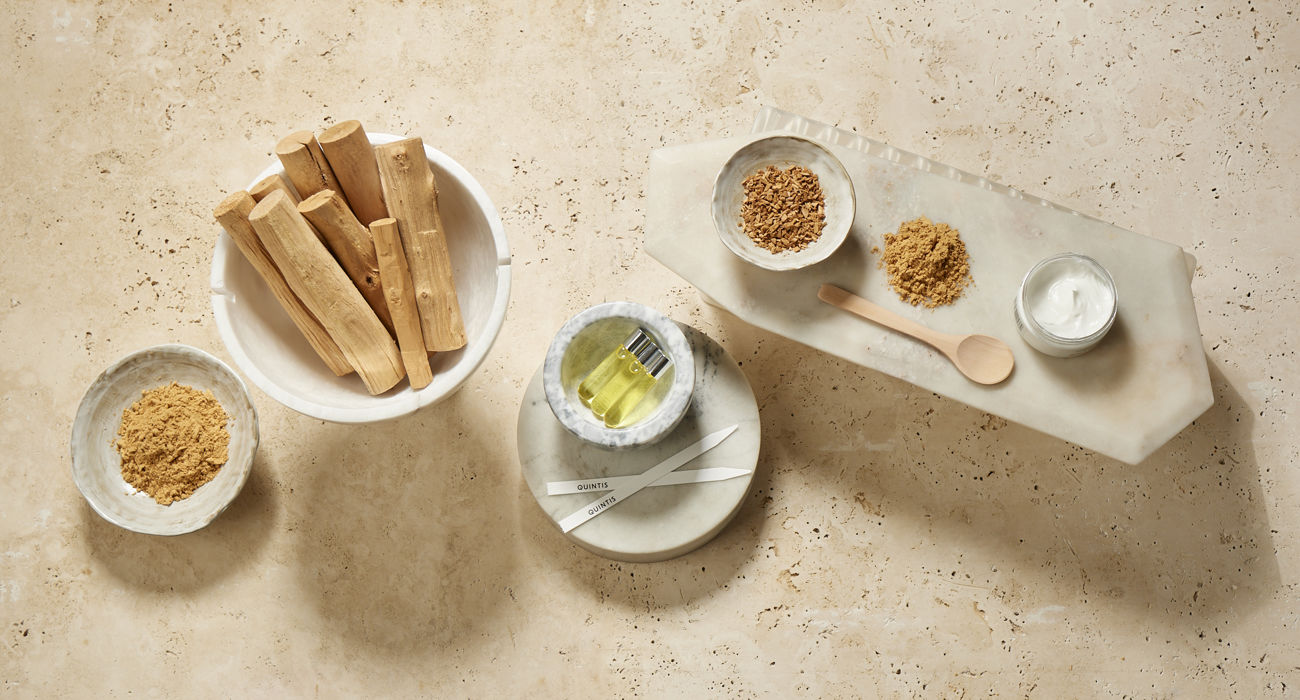Sandalwood is known for its special aroma. But the wood and the oil obtained from it also have powerful ingredients that can be used well for cosmetic products. In an interview with COSSMA Magazine, Dr Dhanushka Hettiarachchi, Product Manager at Quintis Sandalwood, talks about the potential of sandalwood.
Below is the interview transcript published in COSSMA 11/2021, www.cossma.com.
COSSMA: What exactly is meant by “Indian sandalwood oil” ?
Dhanushka Hettiarachchi: Indian sandalwood, or the scientific term Santalum album, is the traditional source of sandalwood oil. It is native to Southern India, Sri Lanka and Southeast Asia and deep-seated in Indian culture. There are over 15 different sandalwood species found in the Asia Pacific region. Several species produce a highly aromatic wood that retains its fragrance for decades, with Indian and Australian Sandalwood considered the most important of these. Indian sandalwood is loved for its versatility and its oil, wood, and powder offer a myriad of uses in a variety of industries such as aromatherapy, fragrance, cosmetics, incense, Traditional Chinese Medicine, as well as furniture and handicrafts.
How is the oil made up?
The oil is an essential oil made up of 125 natural active components, with the main components being alpha-santalol and beta-santalol. These compounds make up more than 70% of the oil, up to three times more than other sandalwood species.
Alpha and beta santalol are most abundant in the Santalum album species, providing a range of therapeutic benefits, as well as beta-santalol being responsible for the warm, woody, and creamy scent sandalwood is known for.
Which processing steps are necessary for further use?
Sandalwood oil is concentrated in the heartwood, or the centre, of the tree. The trees mature after 15 years and following harvesting, the oil is extracted using a proprietary steam distillation process, which locks in the oil’s most potent volatiles. The oil extracted through this process is 100% pure and natural. With innovative blending and processing methods, a range of oils with different notes that tell different olfactory stories can be created.
The heartwood can also be chipped and ground into fine powder. The powders contain more than 3% pure sandalwood oil and are considered to have therapeutic benefits. With a special micronising technology, powder can be produced that is suitable for most cosmetic products. But the powder can also be customised to specific needs.
How can it be used in cosmetics?
For cosmetics, Santalum album can be utilised in two forms, oil and powder: The distilled oil can be easily incorporated into products like creams, gels, and face washes at different concentrations for deep penetrating action and body care products like natural deodorants. With the pleasant aroma, sandalwood oil is a soothing agent and protects skin from external stressors, making it well suited for anti-ageing and skin protection products.
The powder feels luxurious on application and provides a soft and powdery, non-tacky feeling, thanks to the spherical nature of the particles. The physical characteristics also serve as an emulsifier forming Pickering’s emulsions and help in viscosity modification. The powder is suitable to blend in creams and powders that can give a pleasant topical feel to the skin and provide a concealing effect. And it is suitable as a waterless ingredient in face masks.
A study has found that its effects are said to be even stronger than that of vitamin E. How, and with what results, was this study carried out?
A peer reviewed study, recently commissioned by Quintis, found that Indian sandalwood oil is a more potent antioxidant than vitamin E in protecting the skin against environmental stress such as pollution and blue light. In the study, skin cells were exposed to a source of solar blue light and digital blue light, and those cells produced reactive oxygen species, which begins a cascade of reactions detrimental to healthy skin. However, when the cell cultures were treated with sandalwood oil, production of reactive oxygen species reduced by up to 76%. This was measured against vitamin E as the standard and sandalwood oil performed 30 – 40% better at a recorded reduction.
What do these results mean for the cosmetics industry?
Sandalwood oil is widely recognised for its scent in fragrance, however, its powerful role as an active beauty ingredient is only scratching the surface of what it can offer as a ingredient. Our study found that when isolated skin tissue was exposed to simulated environmental pollution including cigarette and ozone, the enzyme MMP1 which digests the collagen tissue was increased. However, when the skin isolates were treated with sandalwood oil, the enzyme MMP1 was decreased, suggesting the collagen protective effect of Santalum album reduces the appearance of wrinkles and could serve as an effective protective and well-ageing active ingredient in cosmetics and dermatology.
Sandalwood is a multi-purpose natural ingredient that theoretically can replace several ingredients: it can be included in a formulation to reduce the signs of ageing and protect the skin, whilst at the same time adding its inimitable fragrance to a product. Sandalwood is known to calm the mind when applied topically or inhaled, adding a cognitive element to its benefits.
How can manufacturers benefit from using Indian sandalwood oil?
It can be included in cosmetic formulations for its soft woody fragrance and its multi-faceted benefits for the skin. Its active component, alpha-santalol, targets a myriad of skin issues, including well-ageing, acne, and inflammation. From its skin benefits through to its calming properties, Indian sandalwood is a very good ingredient for holistic cosmetics applications.
